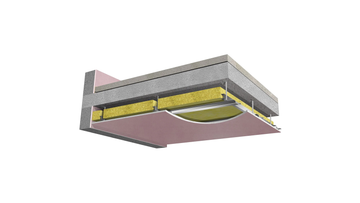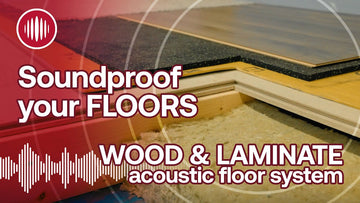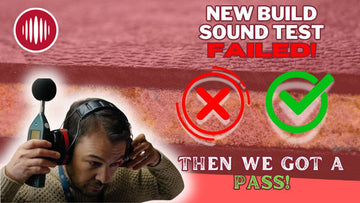Resilient Bars are used to virtually decouple a wall or ceiling from the main structure to reduce vibration and impact noise. They are suitable for use in refurbishments and new build constructions; particularly in timber frame structures and suitable for use on the underside of timber and metal joisted construction at 600mm or 450mm centres. They can also be used to separate timber and metal studwork or masonry walls.
Resilient Bars are thin vibration absorbing steel channels which are used on timber studs for walls and fixed beneath timber joists for ceilings. This solution is designed to create a 30mm void within the construction which optimises acoustic performance by reducing sound transmission through ceiling and wall structures. This allows the new wall or ceiling to be de-coupled from the main structure and will reduce both vibration and impact noise penetration.
Resilient Bar for Ceilings
Resilient Bars are essential for bringing suspended timber floors into compliance with Building Regulations Part E (England and Wales), Section 5 (Scotland) and Part G (Northern Ireland) by achieving noise control through converted separating floors for flats. When used in connection with other sound insulating materials, the resilient bars will create an effective acoustic break between the bottom of existing joists and ceilings.
Alternatively, Noise Reducing Resilient Bars can be supported by 50mm square battens screwed to the underside of any existing ceiling. The fitting of the Bars along with a double layer of 12.5mm acoustic plasterboard will achieve around 11dB improvement. Combined with our 100mm Rockwwool Flexi-Slab between the joists and a double layer of 12.5mm Acoustic Plasterboard, this sound reduction solution would achieve a 16dB improvement.
Resilient Bars used with Acoustic Plasterboard
Acoustic plasterboard can be screwed to the corrugated section of the Resilient Bar using self-drilling screws. For optimised acoustic performance, two layers of 25mm thickness (minimum) should be installed. Using 50mm of Rockwoll Flexi-Slab would further enhance the acoustic performance when installed between the battens before fixing the acoustic plasterboard.
When installed beneath an existing ceiling with Flexi-Slab and 30mm of plasterboard, expected improvements in both airborne noise and impact sound would achieve 300% improvement and can be further enhanced if SoundBlocker Membrane is applied between the acoustic plasterboard layers.
Resilient Bars for Walls
Resilient Bar systems are used to help reduce noise transmission between wall structures. Resilient Bars are also recommended to upgrade party walls; particularly effective at reducing loud music or bass sound. Ideally you would build a new stud batten frame spaced about 25mm away from the existing wall.
This would create a sealed air gap between the new wall and the existing one. Fill in between the studs with Rockwool Flexi-Slab and it does not matter if the wool comes into contact with the existing wall. This is loose fitted and should not be installed too tightly. Screw the Resilient Bars onto the frame horizontally using self-drilling screws followed by a layer of 12.5 mm Acoustic Plasterboard.
We recommend using a layer of Soundproof Matting bonded to the first layer of plasterboard with our contact adhesive.
To finish the application, add a final layer of acoustic plasterboard. You need to make sure that both layers of plasterboard do not touch the surrounding walls, floor or ceiling. Fill in the small gap with flexible non-hardening acoustic sealant and then your whole system will be independent and floating on the bars.
For questions on how to install and meet building regulations, please contact a member of our team






